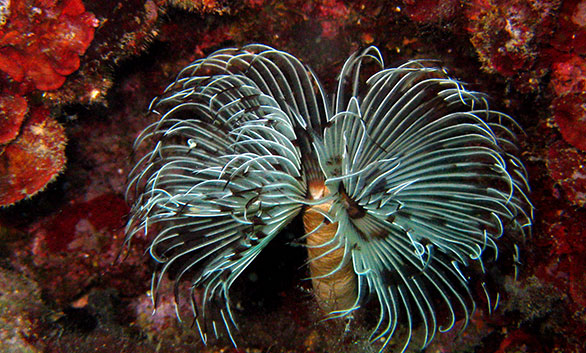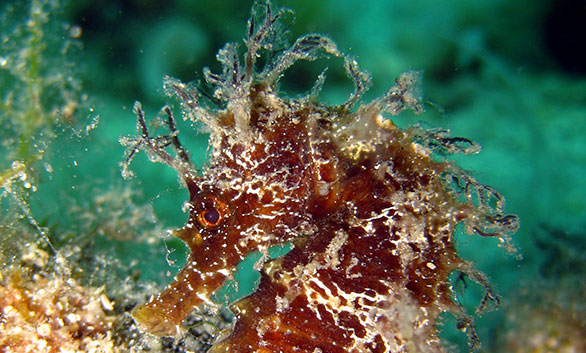
Submarine relief
Kostrena coast has always attracted numerous walkers, swimmers and recreationists as it is one of the most beautiful promenades by the sea where dense sub Mediterranean and Mediterranean vegetation touches the coastal area of steep karst rocks, numerous caves and half caves as well as its pebbles beaches. Although the Kostrena coast is roughly indented, its sea bed relief is very diverse so that, by the coastal area itself, steep areas can be found that separate the shallow from the deep part of the sea bed.

Protected area
The climatic characteristics, the types of sea bottom and the influence of human activities have resulted in the development of sea bottom communities. So in the area of tide and low tide a strong influence of submarine springs can be found where, great clusters of mussels (Mytilus galloprovincialis) have developed on the rocky sea bottom. Besides these shellfish, the common barnacle (Balanus perforatus) can often be found in this area which bears a higher level of wastewaters.
Kostrena’s coastal area is located in the north-eastern part of the Rijeka Bay, and extends from Martinšćica Bay to the entrance of Bakar Bay. This part of the coast as well as the whole of the northern coast of Rijeka’s Bay is influenced by a number of human activities, from the effect of communal wastewaters, smaller ports, shipyards, to athermal power plant and an oil refinery. Then again, the Kostrena coast has always attracted numerous walkers, swimmers and recreationists as it is one of the most beautiful promenades by the sea where dense sub Mediterranean and Mediterranean vegetation touches the coastal area of steep karst rocks, numerous caves and half caves as well as its pebbles beaches. Although the Kostrena coast is roughly indented, its sea bed relief is very diverse so that, by the coastal area itself, steep areas can be found that separate the shallow from the deep part of the sea bed.
The climatic characteristics, the types of sea bottom and the influence of human activities have resulted in the development of sea bottom communities. So in the area of tide and low tide a strong influence of submarine springs can be found where, great clusters of mussels (Mytilus galloprovincialis) have developed on the rocky sea bottom. Besides these shellfish, the common barnacle (Balanus perforatus) can often be found in this area which bears a higher level of wastewaters. Although in the past dense settlements could be found here, today we can find smaller clusters and less developed examples of our endemic species, the Adriatic brown macro alga (Fucus virsoides). In the shallower waters, in the area that is continually submerged, a community of infralittoral algae can be found during the summer months on the stony bottom at up to 5 m depth forming a whitish rug of Acetabularia acetabulum and the brown alga Padina pavonica, and our attention is attracted by the yellow finger-like extensions of the Yellow Tube Sponge (Aplysina aerophoba). The sea bottom is densely overgrown with vegetation and is suitable for the settlement of a number of other organisms: from polychaetes, gastropoda, bivalves, crustaceans, echinoderms to bottom fish (comb tooth blennies, gobies, Mediterranean rainbow wrasse, Chromis chromis, Salema porgy). With a gradual increase in depth, the stony sea bottom changes into sand or a mixture of stone and sand, and has developed a covering of brown and green algae (Dictyota dichotoma, Codium tomentosum, Codium bursa) as well as an accompanying species of sea cucumbers, sea urchins and starfish. Examples, and sometimes rarer turfs are often widely diffused, such as alga from the Cystoseira family that have only been preserved in two smaller areas of the Kostrena sea bed. On the muddy sandy bottom of the Svežanj Bay the remains of Cymodocea nodosa sea grass can be found where the Hippocampus hippocampus seahorse still finds a suitable habitat.
The larger surfaces of sandy bottom with visible and faster deposits of particles is a suitable habitat for the colonies of Cladocora cespitosa, a ball-like, stone coral and widely spread Cnidaria, the solitary coral Balanophyllia europaea and the golden anemone Condylactis aurantiaca.
The steep and darker stone bottoms by the shore or a bit further away from the shore are frequent in the Kostrena sea bed and are covered with green (Halimeda tuna) and red (Peyssonnelia squamaria) algae that completely cover the rigid and steep bottoms. The steep shore, the lesser light penetration and the stronger currents of sea water are suitable for the development of coral communities and examples of sea fan (Eunicella cavolinii) are still preserved even at a depth of 12 metres. These conditions favour the development of settlements of Yellow Cluster Anemone (Parazoanthus axinellae) covering an area under the rocks up to 3 m in depth as well as on the deeper rocky bottom. On the steep sea bottom, from 30 to 40 metres deep, a coral community has developed where the fauna of sponges has prevailed, particularly the yellow cave sponge Aplysina cavernicola. The Axinella cannabina is very rare and attracts attention with its size. In the free water close to the sea bottom there are frequent shoals of picarels, bogues and saddled sea breams. In places where the rocky bottom disappears, a bottom rich in rock fragments and tough remains of dead organisms continues. The bottom seems deserted, but most organisms live on the sea bottom so that our attention is attracted by a sea cucumber, a starfish or we might watch the wide variety of colours and elegant movements of the Mediterranean Crinoid (Antedon mediterranea) with enthusiasm. As we move away from the shore, the bottom is covered with tinier particles and turns into a muddy argillaceous surface with fauna including organisms that live on the sea bottom itself and prevail in the Rijeka Bay.
This is why the coastal areas are still preserved, especially the coral communities where the sea fan Eunicella cavolinii dominates as well as, the protected species of algae (Fucus virsoides, Cystoseira corniculata), sea grass (Cymodocea nodosa), sponges (Aplysina cavernicola, Axinella cannabina, Tethya sp.), Cnidaria (Eunicella cavolinii, Cladocora cespitosa, Balanophyllia europaea, Condylactis aurantiaca), Echinoderms (Paracentrotus lividus, all sea cucumbers) and fish (Hippocampus hippocampus). The reason this initiative is being carried out is to proclaim part of the Kostrena sea bed as a protected area with the purpose of preserving its bio-diversity and further development based on the directions and principles of sustainable development.


